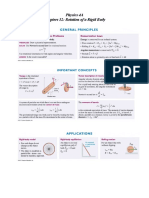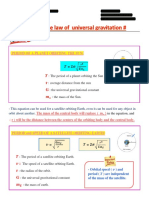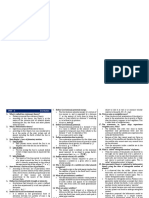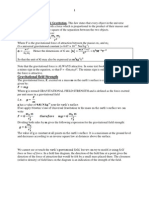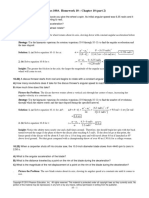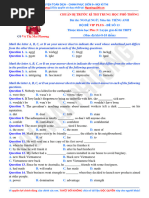GRABSUM School Inc. Name: Grade Level and Section: 12 - STEM
GRABSUM School Inc. Name: Grade Level and Section: 12 - STEM
Uploaded by
Wendell CapiliCopyright:
Available Formats
GRABSUM School Inc. Name: Grade Level and Section: 12 - STEM
GRABSUM School Inc. Name: Grade Level and Section: 12 - STEM
Uploaded by
Wendell CapiliOriginal Title
Copyright
Available Formats
Share this document
Did you find this document useful?
Is this content inappropriate?
Copyright:
Available Formats
GRABSUM School Inc. Name: Grade Level and Section: 12 - STEM
GRABSUM School Inc. Name: Grade Level and Section: 12 - STEM
Uploaded by
Wendell CapiliCopyright:
Available Formats
GRABSUM School Inc.
SENIOR HIGH SCHOOL DEPARTMENT
Name: Grade level and section: 12 - STEM
Unit: 2 Subject: General Physics 1 Module: 9
MOTION OF HEAVENLY BODIES
Learning Competencies
At the end of the lesson, you will be able to:
Use Newton’s law of gravitation to infer gravitational force, weight, and acceleration due to
gravity
Discuss the physical significance of gravitational field
Apply the concept of gravitational potential energy in physics problems
Calculate quantities related to planetary or satellite motion
Overview
This module was designed and written with you in mind. The scope of this module permits it to be
used in many different learning situations. The language used recognizes the diverse vocabulary level of
students. The lessons are arranged to follow the standard sequence of the course.
Introduction
Danish astronomer Tycho Brahe recorded accurate measurement of the motion of planets
around the sun. Johannes Kepler, after painstakingly analyzing and studying these measurements for
22 years, formulated his three laws of planetary motion.
On the other hand, it was said that Isaac Newton discovered the physical law that governs an
apple falling from the tree to the ground. He realized that the apple is attracted to Earth in the same way that
Earth is attracted to the apple. He added that this attraction between Earth and the apple must also hold true
for the planets, Earth’s moon, the sun, and for every object in the universe. With this idea, Newton formulated
the law of universal gravitation.
Newton’s Law of Universal Gravitation
Earth and other planets rotate in nearly circular orbits around the sun. Thus, the sun must be
exerting a centripetal force on the planets. Newton proposed that this force is just a part of a universal
attraction called gravitation. Gravitation happens between all bodies by virtue of their masses.
Newton’s law of universal gravitation states that every object in the universe attracts every other
object with a force proportional to the product of their masses, m 1 and m2, and inversely proportional to the
square of the distance r between them. In equation,
Where G is the universal gravitation constant equal to 6.674 x 10-11 N•m2/kg2.
EXAMPLE PROBLEM 1:
Determine the force of gravitational attraction between the earth (m = 6 x 1024 kg) and a 70-kg
physics student if the student is standing at sea level, a distance of 6.4 x 106 m from earth's center.
SOLUTION:
The solution of the problem involves substituting known values of G (6.674 x 10-11 N m2/kg2), m1 (6 x 1024 kg),
m2 (70 kg) and d (6.4 x 106 m) into the universal gravitation equation and solving for Fgrav. The solution is as
follows:
General Physics 1 | Ms. Nezell C. Gamboa Page 1
CHECKPOINT 1!!
Compare the gravitational force of attraction on a 1.0 kg object when it is at the
surface of the moon to the gravitational force on the same objects when it is at the
surface of Earth. (mass of the moon = 7.35 x10 22 kg; radius of the moon = 1.738 x10 6 m;
mass of Earth = 6 x1024 kg; radius of Earth = 6.4 x106 m)
Did you get the correct answer? If yes, CONGRATULATIONS! You’ve gain 3 stars!
You are now a WARRIOR and can proceed to the next level!
"Stay in a good mood.. every day!"
Acceleration Due to Gravity
The acceleration due to gravity at a particular distance r from the center of a planet of mass M
can be determined using Newton’s second law of motion and law of universal gravitation.
At the surface of Earth, g = 9.8 m/s2.
EXAMPLE PROBLEM 2:
What is the value of the acceleration due to gravity g of an object at an altitude equal to twice the radius
of Earth? (radius of Earth = 6.4 x106 m)
SOLUTION:
The distance from the center of Earth = (R E + 2RE) = 3RE
( )
[ ]
CHECKPOINT 2!!
What is the value of acceleration on the surface of a planet that has twice the mass of
Earth and twice its radius.
Did you get the correct answer? If yes, CONGRATULATIONS! Freya wants you to move to the
next level. You earned 3 stars and now an ELITE! And if not, it’s okay, try harder! Answer the questions
again.
"A scar.. is the testament of a warrior's honor."
General Physics 1 | Ms. Nezell C. Gamboa Page 2
Satellite Motion
A satellite is any object that orbits a plant or a star. Satellites may be neutral or artificial. The
moon that orbits Earth is a natural satellite. The International Space Station is an artificial satellite.
The orbit of a satellite is nearly circular. Centripetal force is needed to keep this satellite moving
in a circle. This centripetal force is provided by the force of attraction between the satellite and the planet
it orbits.
Recall that . But , where T is the period. Therefore,
Solving for T,
√
Where M is the mass of the body about which the satellite orbits, r is the radius of the orbit, an G
is the gravitational constant equal to 6.674x10 -11 N•m2/kg2.
A syncom, which is a short term for a synchronous communication satellite, is a satellite having
the same period of revolution to the period of rotation of the planet it orbits. We view events happening in
distant places “live via satellite”. Such satellite is in synchronous orbit with Earth or in geosynchronous orbit.
The satellite also completes one revolution in 24 hours. Thus, it appears to stay directly over a fixed point
above Earth’s sky. In this way, stationary antennas called satellite dishes that are placed in our homes
receive signals without changing orientations from a revolving satellite.
EXAMPLE PROBLEM 3:
What should be the altitude of a satellite synchronous with Earth?
SOLUTION:
√ √
Thus the satellite is at an altitude of 4.2 x107 m.
CHECKPOINT 3!!
Ganymede is one of the moons of Jupiter. Ganymede’s period of revolution around
Jupiter is 7.16 Earth days and an orbital radius of about 1.07 x109 m. find the mass of
Jupiter.
Did you get the all the correct answer? If yes, CONGRATULATIONS! Ruby approved you to move
to the next level. You’ve gained 4 stars are now a MASTER! And if not, it’s okay, try harder! Answer the
questions again.
"I love the feeling of chasing prey!"
General Physics 1 | Ms. Nezell C. Gamboa Page 3
Gravitational Potential Energy and Escape Velocity
In general, gravitational potential energy is defined as the work needed to move an object
from an initial position to a final position. We consider the ground as the reference of gravitational
potential energy for bodies near Earth’s surface. However, in outer space where objects are very far
from Earth’s surface, we consider infinity as our reference point for zero potential energy. Negative work
is done to bring an object closer to Earth. Thus, when using infinity as reference point, gravitational
potential energy is always negative.
Escape velocity from an astronomical body is defined to be the minimum velocity an object
must have to escape its gravitational field without ever falling back. It can be calculated by equating
the initial kinetic energy of the moving body to the work necessary to overcome the gravity at the
surface of the astronomical body, neglecting friction. In symbols,
The distance r is equal to the radius R of the astronomical body with mass M. solving for the
escape velocity,
Recall that . Thus,the equation can be written as
√
The equation is only true for celestial bodies near Earth.
EXAMPLE PROBLEM 4:
What is the escape speed from planet Earth given that the mass of Earth is 6 x10 24 kg and its radius is 6.4
x106 m?
SOLUTION:
√ √
We can also use
√ √ ( )
CHECKPOINT 4!!
a. What is a satellite?
____________________________________________________________________________________
______________________________________________________________________________
b. What is meant by escape velocity?
____________________________________________________________________________________
______________________________________________________________________________
The moon has a mass of 7.35 x1022 kg and a radius of 1.738 x106 m. At what speed must a rocket be
launched from the surface of the moon so as not to fall back to the moon?
Did you answer the questions correctly? If yes, CONGRATULATIONS! You passed Hanabi’s
challenge and gained 5 stars! You are now a GRAND MASTER! And if not, it’s okay, try harder! Answer the
questions again.
"The enemy often knows you better than you do."
References:
Baltazar & Tolentino. General Physics 1 Senior High School. 2017. Phoenix Publishing House Inc. 927 Quezon Avenue, Quezon City
General Physics 1 | Ms. Nezell C. Gamboa Page 4
You might also like
- Excerpt From 'A Prayer Journal' by Flannery O'ConnorDocument4 pagesExcerpt From 'A Prayer Journal' by Flannery O'ConnorOnPointRadioNo ratings yet
- Practice Quiz On GravitationDocument7 pagesPractice Quiz On GravitationAli TayyubNo ratings yet
- Chapter 12 - Rotation of A Rigid Body - SolutionsDocument16 pagesChapter 12 - Rotation of A Rigid Body - SolutionsWendell CapiliNo ratings yet
- Product Description - PD 45003-7.16en Material No. 114374 Nisaplin®Document3 pagesProduct Description - PD 45003-7.16en Material No. 114374 Nisaplin®Mohamed BayomyNo ratings yet
- Final Paper AraucoDocument4 pagesFinal Paper Araucopaulaboston2011100% (2)
- GRABSUM School Inc. Name: Grade Level and Section: 12 - STEMDocument4 pagesGRABSUM School Inc. Name: Grade Level and Section: 12 - STEMWendell CapiliNo ratings yet
- Gravitational Force WorksheetDocument4 pagesGravitational Force WorksheetAnjela AprilNo ratings yet
- Physics 1Document27 pagesPhysics 1vafantasy101No ratings yet
- General Physics 1 Quarter 2 WEEK 2Document5 pagesGeneral Physics 1 Quarter 2 WEEK 2Normal Fan100% (2)
- General PhysicsDocument15 pagesGeneral Physicsmar liaNo ratings yet
- 12 - Physics1 - Q2-Mod12-Law of Universal GravityDocument22 pages12 - Physics1 - Q2-Mod12-Law of Universal GravityGevin DuetchNo ratings yet
- W2 GravityDocument41 pagesW2 GravityElla VillanuevaNo ratings yet
- General Physics 1: GravityDocument16 pagesGeneral Physics 1: GravityJheremy Charles Morales MorteraNo ratings yet
- Chapter 12 Skill BuildingDocument19 pagesChapter 12 Skill Buildingaabass4shareNo ratings yet
- Theme: Newtonian Mechanics Chapter 3: GravitationDocument11 pagesTheme: Newtonian Mechanics Chapter 3: GravitationvelavanNo ratings yet
- GP1 - Q2 - Week 2Document9 pagesGP1 - Q2 - Week 2Shekaina Faith Cuizon Lozada100% (2)
- HSC Physics Notes: SpaceDocument12 pagesHSC Physics Notes: SpacechloeNo ratings yet
- Gravity Notes PhysicsDocument44 pagesGravity Notes PhysicsCash Cash CashNo ratings yet
- TOPIC 2 - Gravitation and GPEDocument57 pagesTOPIC 2 - Gravitation and GPELuke kenneth Macalawa100% (1)
- PHYS 0100: DR Xsitaaz Chadee Ms. Nalini DookieDocument27 pagesPHYS 0100: DR Xsitaaz Chadee Ms. Nalini DookieJohn McNellNo ratings yet
- Physics 10 Revision Answer KeyDocument6 pagesPhysics 10 Revision Answer KeygoldenaboudyNo ratings yet
- The Cruel PrinceDocument4 pagesThe Cruel PrinceAsma Al AhbabiNo ratings yet
- HSC Physics in MonthDocument162 pagesHSC Physics in MonthZarina100% (2)
- Phys Int CC CH 6 - Universal Graviation - Answers PDFDocument5 pagesPhys Int CC CH 6 - Universal Graviation - Answers PDFGIDZANIA PLAYSNo ratings yet
- Week 9 Gravitational ForceDocument30 pagesWeek 9 Gravitational ForcetaiwoothnielNo ratings yet
- GravityDocument28 pagesGravityjbath43No ratings yet
- GenPhys1 12 Q2 Mod3 GravityDocument12 pagesGenPhys1 12 Q2 Mod3 GravityararosahazekiahNo ratings yet
- Gravitation Paper 04Document9 pagesGravitation Paper 04jeetjeetghoraiNo ratings yet
- Class 11 CH 8Document21 pagesClass 11 CH 8Freddy Joe VargheseNo ratings yet
- 11 Phy - Gravitation - QN BankDocument42 pages11 Phy - Gravitation - QN BankMohit DhaundiyalNo ratings yet
- NCERT Solutions Class 9 Science Chapter 10 GravitationDocument16 pagesNCERT Solutions Class 9 Science Chapter 10 GravitationDhwityNo ratings yet
- GravitationDocument33 pagesGravitationKarl OliverosNo ratings yet
- 1 - GravityDocument6 pages1 - Gravitynanio_7No ratings yet
- Lecture 6 - PH101 - Chapter 13 - Slides and Examples - DR NaderDocument29 pagesLecture 6 - PH101 - Chapter 13 - Slides and Examples - DR NaderHebatallah Mujahed Mohmoud KanaNo ratings yet
- Physics Chapter 3 f4 KSSM (SPM Notes 4.0)Document11 pagesPhysics Chapter 3 f4 KSSM (SPM Notes 4.0)dinesh chandranNo ratings yet
- Difference Between G' and G':: Value of G On EarthDocument17 pagesDifference Between G' and G':: Value of G On EarthJaipriya PriyaNo ratings yet
- Physics Chapter 2 F4 KSSM (SPM Notes 4.0)Document11 pagesPhysics Chapter 2 F4 KSSM (SPM Notes 4.0)harwezelNo ratings yet
- Gravitational ForceDocument40 pagesGravitational Forcethunder32xNo ratings yet
- Chap 11 SMDocument96 pagesChap 11 SMananiasrenato100% (1)
- FORCEDocument29 pagesFORCEkinjalbhandari77No ratings yet
- Newtons Law of Universal GravitationDocument25 pagesNewtons Law of Universal Gravitationaurhonjuliocelso0707No ratings yet
- Dynamics Problems Set712 Solutions 2h1299aDocument5 pagesDynamics Problems Set712 Solutions 2h1299arabinNo ratings yet
- Caballero-Genphysics 1 ModuleDocument8 pagesCaballero-Genphysics 1 ModuleRenz Nikko CaballeroNo ratings yet
- GravitationDocument3 pagesGravitationChirag ReddyNo ratings yet
- Q2W4 Gravitational Potential Energy Keplers Law of Planetary MotionDocument31 pagesQ2W4 Gravitational Potential Energy Keplers Law of Planetary Motionhikkiro hikkiNo ratings yet
- Physical Geodesy Handout 1Document3 pagesPhysical Geodesy Handout 1Ro Land Jr.No ratings yet
- X Science SE NotesDocument112 pagesX Science SE Noteskulsumbii786No ratings yet
- Class Xi Isc Gravitation AssignmentsDocument2 pagesClass Xi Isc Gravitation Assignmentsanimalphysio1511No ratings yet
- 11 Phy - Gravitation - QN Bank - Only QnsDocument3 pages11 Phy - Gravitation - QN Bank - Only QnsMohit DhaundiyalNo ratings yet
- GravitationDocument12 pagesGravitationMovie LitNo ratings yet
- Chapter 5 GravitationDocument4 pagesChapter 5 Gravitationzair aliNo ratings yet
- Gravitation - D.K. - FINALDocument35 pagesGravitation - D.K. - FINALsirisha.kurma2008No ratings yet
- 11 - Vol 2 Phy MatricDocument17 pages11 - Vol 2 Phy MatricvalarmathiNo ratings yet
- Physics Review NotsDocument2 pagesPhysics Review NotsPADILLA REVIEWSNo ratings yet
- Gravitation: Very Short Answer Type Questions-Pg-100Document53 pagesGravitation: Very Short Answer Type Questions-Pg-100DX GamingNo ratings yet
- NCERT Solutions For Class 9 Science Chapter 10 GravitationDocument15 pagesNCERT Solutions For Class 9 Science Chapter 10 GravitationSangam Entertainment StoreNo ratings yet
- gravitation- ncert aanwer keyDocument13 pagesgravitation- ncert aanwer keyim.shivi.gahlautNo ratings yet
- A2 Gravitational FieldDocument57 pagesA2 Gravitational Fieldincorrect37No ratings yet
- Q2W3 Newtons Law of Gravitation Keplers Law of Planetary MotionDocument16 pagesQ2W3 Newtons Law of Gravitation Keplers Law of Planetary Motionhikkiro hikkiNo ratings yet
- GRAVITATIONDocument15 pagesGRAVITATIONmuddu00007No ratings yet
- 1_Q2 Physics1Document14 pages1_Q2 Physics1Cuy CoyNo ratings yet
- Important Questions Class 11 Physics Chapter 8 - GravitationDocument8 pagesImportant Questions Class 11 Physics Chapter 8 - GravitationAmit GhoshNo ratings yet
- Universal GravitationDocument6 pagesUniversal GravitationKimmola K SmallNo ratings yet
- GRABSUM School Inc. Masalukot 1 Candelaria Quezon SY. 2020-2021Document7 pagesGRABSUM School Inc. Masalukot 1 Candelaria Quezon SY. 2020-2021Wendell CapiliNo ratings yet
- Physics 100A Homework 10 - Chapter 10 (Part 2)Document4 pagesPhysics 100A Homework 10 - Chapter 10 (Part 2)Wendell CapiliNo ratings yet
- GRABSUM School Inc. Name: Grade Level and Section: 12 - STEMDocument6 pagesGRABSUM School Inc. Name: Grade Level and Section: 12 - STEMWendell CapiliNo ratings yet
- Understanding School Social Workers - Roles in Bullying Prevention PDFDocument71 pagesUnderstanding School Social Workers - Roles in Bullying Prevention PDFWendell CapiliNo ratings yet
- Fpubh 07 00075 PDFDocument15 pagesFpubh 07 00075 PDFWendell CapiliNo ratings yet
- List of VCD Karaoke Produced by Dynasty Audio Video, Inc.Document28 pagesList of VCD Karaoke Produced by Dynasty Audio Video, Inc.John Carlo A. Velonza100% (1)
- Titrimetric Methods of AnalysisDocument28 pagesTitrimetric Methods of AnalysisPraveen Kumar Avvaru100% (2)
- Arvin Victor Maruli - 01311171292 - Makalah RNWDocument11 pagesArvin Victor Maruli - 01311171292 - Makalah RNWArvin VictorNo ratings yet
- Introduction To Retail: 10/6/2017 Retailing Management - Swapna Pradhan 1Document15 pagesIntroduction To Retail: 10/6/2017 Retailing Management - Swapna Pradhan 1Adarsh KrishnaNo ratings yet
- The Effects of Coyote Removal in TexasDocument4 pagesThe Effects of Coyote Removal in Texasapi-264463866100% (2)
- Holly Sanusi, Adrian Umboh, Valentine UmbohDocument5 pagesHolly Sanusi, Adrian Umboh, Valentine UmbohTemiNo ratings yet
- Plus3 Pro3mplusdevipplus13Document9 pagesPlus3 Pro3mplusdevipplus13Ánh NgọcNo ratings yet
- Math 1 Chapter 2 Consumer MathDocument24 pagesMath 1 Chapter 2 Consumer MathJohn Christian Elmo TabaneraNo ratings yet
- Equity Note - Square Pharmaceuticals LTD - February 2019Document4 pagesEquity Note - Square Pharmaceuticals LTD - February 2019Shamim Parvez DurjoyNo ratings yet
- 2019 Spring Syllabus ISM6562 Muma 1Document8 pages2019 Spring Syllabus ISM6562 Muma 1SaitejNo ratings yet
- Hygiene - Workbook - 2019-34284-101202 5Document191 pagesHygiene - Workbook - 2019-34284-101202 5q8k5t64cn5No ratings yet
- Duane Elgin - Collective Consciousness and Cultural HealingDocument43 pagesDuane Elgin - Collective Consciousness and Cultural HealingAndross580No ratings yet
- ABC News/Ipsos Poll Sept. 13Document4 pagesABC News/Ipsos Poll Sept. 13ABC News PoliticsNo ratings yet
- Plan and Organize Work LO1Document8 pagesPlan and Organize Work LO1anwar kadiNo ratings yet
- What Is Solid WasteDocument7 pagesWhat Is Solid Wastemunis2112No ratings yet
- Chemical Bonding 1 and 2 2020 PDFDocument42 pagesChemical Bonding 1 and 2 2020 PDFAyoub BelNo ratings yet
- PassatDocument52 pagesPassatVladBogdanNo ratings yet
- Karachi University Business School University of Karachi Bs (Bba) - ViiDocument7 pagesKarachi University Business School University of Karachi Bs (Bba) - ViiSaif ali KhanNo ratings yet
- Local Taxes PDFDocument16 pagesLocal Taxes PDFRobert RamirezNo ratings yet
- ASPINWALL - Profiled Superabrasive Grinding Wheels For The Machining of A Nickel Based SuperalloyDocument4 pagesASPINWALL - Profiled Superabrasive Grinding Wheels For The Machining of A Nickel Based SuperalloyLuis Fillipe Lopes TorresNo ratings yet
- NOUNSDocument11 pagesNOUNSKAMALNo ratings yet
- Order Form: QTY PriceDocument2 pagesOrder Form: QTY PriceCecil Costales - BravoNo ratings yet
- Southern Breeze, Summer Wind Answer To Temporary Injunction RequestDocument5 pagesSouthern Breeze, Summer Wind Answer To Temporary Injunction RequestKristinNo ratings yet
- RAC Failover PDFDocument1 pageRAC Failover PDFdesaesNo ratings yet
- DAV Presidents (Photo Accompanying Content To Be As Succinct As Possible)Document10 pagesDAV Presidents (Photo Accompanying Content To Be As Succinct As Possible)rajivNo ratings yet
- Basic Full Circle Trust Diagnostic Report 20200805154233Document1 pageBasic Full Circle Trust Diagnostic Report 20200805154233Jagat SinghNo ratings yet
- Doctor Who - The Official Annual 2019 - Lang, Paul, Author - 2018 - London - BBC Children's Books - 9781405933766 - Anna's ArchiveDocument62 pagesDoctor Who - The Official Annual 2019 - Lang, Paul, Author - 2018 - London - BBC Children's Books - 9781405933766 - Anna's ArchiveBardiya GhasemzadehNo ratings yet


